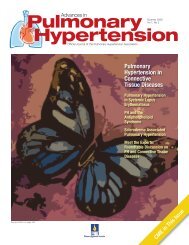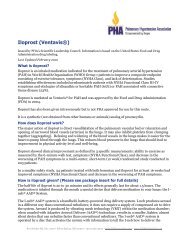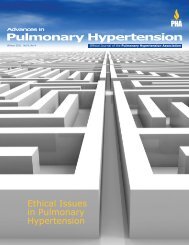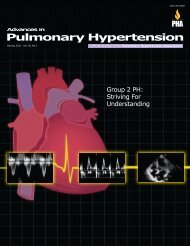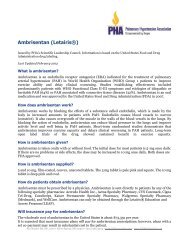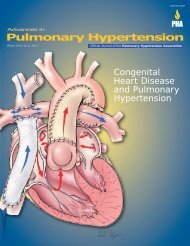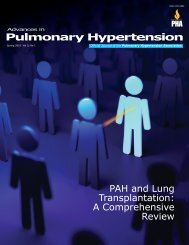Vol 7, No 3 - PHA Online University
Vol 7, No 3 - PHA Online University
Vol 7, No 3 - PHA Online University
Create successful ePaper yourself
Turn your PDF publications into a flip-book with our unique Google optimized e-Paper software.
Continuing Medical Education Section<br />
The Metabolic Syndrome and Cardiac Function<br />
Heiko Bugger, MD, PhD and E. Dale Abel, MD, PhD<br />
Division of Endocrinology, Metabolism and Diabetes<br />
Program in Human Molecular Biology and Genetics<br />
<strong>University</strong> of Utah School of Medicine<br />
Salt Lake City, Utah<br />
Heiko Bugger, MD<br />
E. Dale Abel, MD<br />
The metabolic syndrome includes obesity, insulin resistance, dyslipidemia,<br />
and type 2 diabetes mellitus. It increases the risk of developing<br />
cardiovascular diseases, including heart failure. Evidence<br />
is emerging that changes in energy metabolism might contribute<br />
to the development of cardiac myocyte contractile dysfunction.<br />
The focus of our laboratory is in understanding the potential molecular<br />
mechanisms for these abnormalities.<br />
Over 40% of US citizens older than 60 years have metabolic<br />
syndrome and the prevalence of the metabolic syndrome parallels<br />
the global epidemic of obesity and diabetes. 1 What is unknown<br />
is the prevalence of the metabolic syndrome and/or type 2<br />
diabetes in patients with pulmonary hypertension. More importantly,<br />
the impact that these comorbidities may have on right ventricular<br />
performance and patient outcomes is not known. The<br />
objective of this article is to review the cardiac effects of the metabolic<br />
syndrome and highlight possible areas for investigation in determinants<br />
of right ventricular dysfunction.<br />
Metabolic Alterations<br />
Obesity, insulin resistance and diabetes increase the risk of developing<br />
cardiovascular disease. 2-4 Many believe that the major<br />
determinant of cardiovascular complications in the metabolic syndrome<br />
is coronary artery disease. Our work suggests that the metabolic<br />
alterations that occur in obesity and type 2 diabetes can<br />
also affect cardiac structure and function independently of hypertension<br />
or coronary artery disease. In addition, after adjusting<br />
for age, blood pressure, weight, cholesterol, and coronary artery<br />
disease, obesity is associated with an increased risk of heart failure.<br />
3,5,6 This “diabetic cardiomyopathy” is defined as ventricular<br />
Address for reprints and other correspondence: E. Dale Abel, MD, Chief, Division<br />
of Endocrinology and Professor of Medicine and Biochemistry, Division<br />
of Endocrinology, Metabolism and Diabetes, Program in Human Molecular<br />
Biology and Genetics, <strong>University</strong> of Utah School of Medicine, 15 N. 2030<br />
East, Rm 3110, Salt Lake City, UT 84112; email: stacis@hmbg.utah.edu.<br />
Acknowledgments—Studies in the Abel laboratory are supported by research<br />
grants from the National Institutes of Health: UO1HL70525, UO1 HL087947<br />
(Animal Models of Diabetes Complications Consortium [AMDCC)]); RO1<br />
HL70070 and RO1 HL73167, the American Heart Association, and the Juvenile<br />
Diabetes Research Foundation. Dr Bugger is supported by a postdoctoral<br />
fellowship from the German Research Foundation.<br />
systolic or diastolic dysfunction occurring in diabetic patients in<br />
the absence of coronary artery disease and hypertension. 7-9 Several<br />
studies have identified the presence of lipid material in the<br />
hearts of patients who are obese or have type 2 diabetes who have<br />
had nonischemic heart failure. 10,11 The transcriptional profile of<br />
these lipid-laden hearts is similar to that of the Zucker diabetic rat<br />
(ZDF), an animal model of lipotoxicity and contractile dysfunction,<br />
which suggests that dysregulation of fatty acid metabolism<br />
in failing human hearts may contribute to contractile dysfunction.<br />
Most mechanistic insights into obesity-related cardiomyopathy<br />
and diabetic cardiomyopathy have come from rodent studies. The<br />
most widely investigated models are db/db mice (leptin receptor<br />
mutation), ob/ob mice (leptin deficiency), and ZDF rats (leptin receptor<br />
mutation). All of these models have obesity, insulin resistance,<br />
and hyperglycemia in common, although to varying degrees<br />
in each model. 12,13 These animals do not develop atherosclerosis,<br />
which allows an evaluation of the effects of obesity, insulin resistance,<br />
and type 2 diabetes in the heart that are independent of<br />
coronary artery disease. 13,14 Each of these animal models is associated<br />
with evidence of contractile dysfunction, both systolic and<br />
diastolic, which further supports the existence of an obesity-related<br />
and/or diabetic cardiomyopathy. 15-24<br />
Pathophysiology<br />
Patients with type 2 diabetes have decreased whole-body aerobic<br />
capacity that may be related to decreased expression of mitochondrial<br />
proteins in skeletal muscle. 25-28 Mitochondrial function<br />
and morphology are also abnormal in prediabetic and diabetic<br />
states and include a reduction in overall mitochondrial size and<br />
content and a 30% reduction in ATP synthesis. 29-32 What is not<br />
clear is whether these skeletal muscle mitochondrial abnormalities<br />
represent a genetic predisposition to the metabolic syndrome<br />
or acquired defects. 33,34<br />
Cardiac muscle mitochondria have been less well studied. A<br />
few indirect studies suggest that myocardial mitochondrial function<br />
is altered in obesity and diabetes as evidenced by increased<br />
oxygen consumption and reduced cardiac efficiency. 35 Which are,<br />
in turn, associated with increased myocardial fatty acid use and<br />
impaired glucose tolerance. More direct evidence for cardiac mi-<br />
332 Advances in Pulmonary Hypertension



